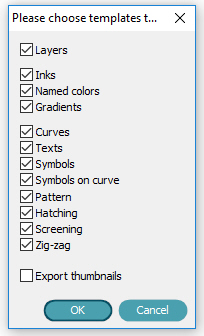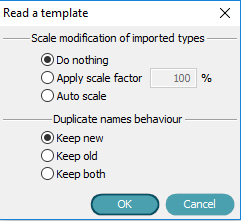
Graphical template creation is a long process. It's important to be able to reuse it other projects. From one project to another, you may not want to keep all created styles: in this case, it is important to be able to clean it.
Click Manage/Graphical template/Export menu. The following panel is displayed:

Select the elements to be exported then click [OK] to validate.
Program opens a standard save panel.
Enter the name of graphical template to be saved. It can be either a *.lkt or a *.xml or a *.lkdt file.
This graphical template is now available for another project.
![]() When graphical template is exported
using *.xml file format, it can be modified in any kind of text editing
software that reads XML.
When graphical template is exported
using *.xml file format, it can be modified in any kind of text editing
software that reads XML.
For more details on xml storage please refer to Methodology/XML storage chapter from this documentation.
![]() *.lkt file format is a binary file and thus it is
not modifiable.
*.lkt file format is a binary file and thus it is
not modifiable.
*.lkdt format is a binary format for storing graphical template with a view to use it as exporting LorikDigital vector mosaics.
An additional file is associated to this file with a *.lkdtr file format. Each type is associated to a unique ID
You can export thumbnails to have a summary of symbol and types used in graphical template.
When you start a new project it is sometimes interesting to start with an existing graphical template, even if you have to update it so that it best fits the current project.
Click  button A standard Windows open panel is
displayed and give the capability to select one of the following file
formats:
button A standard Windows open panel is
displayed and give the capability to select one of the following file
formats:
*.lkt |
LorikSoftware graphical template format |
*.lkc, *.lgm |
LorikSoftware format |
*.xml |
XML format |
*.dry, *.mdry, *.cir, *.mcir |
Old Dry and Cirrus file format |
*.d2rgb |
Old Dry2RGB file format |
*.dryC, *.dryt, *.dryHatch, *.dryPat, *.drySoc, *.dryZig, *.dryS |
Old Dry graphical template file |
*.cirC, *.cirt, *.cirHatch, *.cirPat, *.cirSoc, *.cirZig, *.cirS |
Old Cirrus graphical template file |
Once made your selection, click [Open]
When you read a graphical template saved in XML, you have to select a reference as reading the file. It can be either the names or the unique IDs.
Example: if you import a graphical template containing a curve type named "Electric_power_supply" with a uniqueID equal to 257, in an existing graphical template already containing such a type, it is necessary to take names as a reference. The selection of UniqueIDs could lead to an error.
If you take the names a reference, and for all other import modes, the following panel is displayed:

You have the capability to modify the scale of imported types, applying a scale factor.
![]() This factor is applied to all types, even on font size.
This factor is applied to all types, even on font size.
This option is only available as importing a graphical template in an extraction dataset or a GIS extraction dataset . Using this mode, you do not use the size modification percentage which means that, if the extraction size has been modified, the graphical template is calculated in order to retrieve original types size. For instance, if the dataset is imported at 50% of its original size, the graphical template will be imported at 200%.
Duplicate name behavior deals with specific behavior when importing a graphical template in a project already containing types.
Types are defined by their name and family.
When you import a graphical template, some types may have the same name but different graphic styles.
Existing types are replaced by new ones. Existing associations are re-created.
New types with the same name are not loaded. New possible associations are created, replacing existing associations
Existing types keep their names. Existing associations remains. New types are added using the following extension: "_0" and new possible associations are created.
Click Manage/Graphical template/Clean. The following panel is displayed:
Check the types to be cleaned et click [OK] to perform the operation. All styles from the graphical template not associated to entities of the map are removed.
For each category, removed elements are displayed.
It is possible to scale one or more types of the graphic template. Select types or families to resize. With a right click, select menu "change the scale of the types of the selected families" and choose from the panel the reduction percentage you want to apply to the selection.